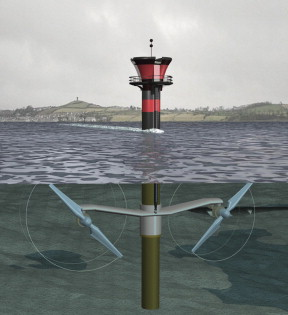
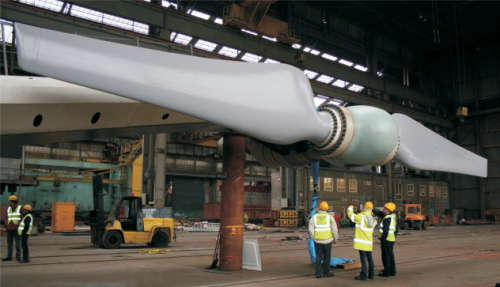
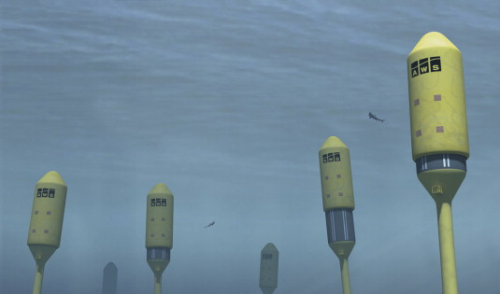
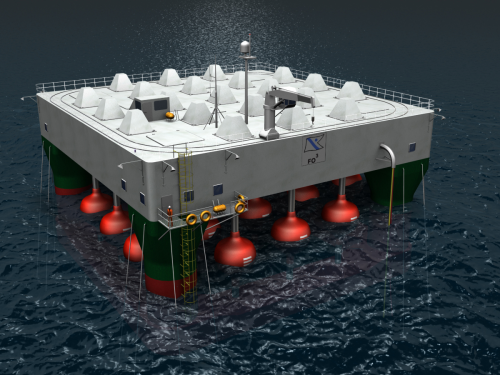
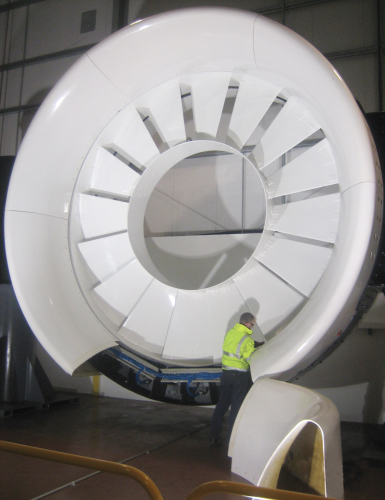
Wind energy has become an established and mature contributor to humankind’s energy supply. Water-based renewables are likely to follow, albeit a decade or more down the line. Prototype and pre-production wave and tidal stream devices are now working or being installed in several locations. And, just as reinforced plastics have proved instrumental in capturing the power of the wind, they look poised to contribute similarly in harnessing water power.
Converting water current to electrical current poses a major materials challenge. The hydrosphere is a particularly hostile environment given that water is some 830 times as dense as air (the exact figure depends on depth); flow is varied, often turbulent and reverses in direction with tidal ebb and flow; moisture ingress is a constant hazard exacerbated by device motion; and maintenance events have to be rare since access to submerged installations is limited.
Another factor is that fatigue, not often a significant consideration with composites, becomes one when a typical service life of 20-25 years in a turbulent environment is intended. According to Angus Fleming, Managing Director of Aviation Enterprises Ltd (AEL), a British company that produces rotors for several firms developing tidal stream generators.
“Until recently, the fatigue aspect was little understood," he says. "As a result, there has been a tendency to over-design rotors, by up to 30% in some cases, to ensure the required durability. This is inefficient, in terms both of material usage and performance.”
When it decided in 2008 to pursue a marine renewables path, AEL embarked on research and development intended to address this deficiency. With backing from the Carbon Trust ( a company set up by the UK government to accelerate the move to a low carbon economy) and others, it has led the way in testing materials and structures, including such features as bonded joints, for the underwater environment. Accelerated ageing testing has been part of its drive.
R&D effort has involved other players including Bristol University, contributing the necessary theoretical underpinning, Advanced Composites Group (ACG) as principal materials supplier, and various tidal stream generator developers. A leading focus has been the development of a resin matrix with enhanced fatigue resistance.
Epoxies are generally selected for underwater applications because, of all the resin systems, they are the most resistant to progressive moisture absorption and hydrolytic attack, so development has concentrated on suitable modification of the epoxy polymer for improved fatigue performance. AEL and its partners are working on purpose-developed epoxy resins that will deliver the required combination of properties and ensure the most efficient use of materials.
Fleming believes that current R&D addressing some fundamental issues identified from experience to date with pre-production blades will clear the way for volume production of reliable blades for the rotors of farm-scale tidal stream generators.
“Once the R&D and the test programme have been completed, we will be able to move ahead on a much firmer design footing than at present,” he declares. “We’ll be able to design appropriately for all the main load conditions.”
One of the companies AEL works closely with is UK-based Marine Current Turbines (MCT), whose 1.2 MW SeaGen tidal stream generator is installed in Strangford Narrows, Northern Ireland. AEL produced the 11 m diameter rotors for MCT’s original Seaflow unit, which performed successfully off Lynmouth, Devon, for a couple of years, and subsequently the 16 m rotors for the full-scale SeaGen. After initial teething troubles in which three blades were broken due to control system deficiencies, SeaGen is now working well, feeding up to its full rated power into the grid. This is according to MCT Technical Director Peter Frankel, who says that SeaGen was the first commercial-scale device to enter service and is the largest piece of rotating machinery installed in the sea anywhere.
The fact that power varies with the density of the medium and with the cube of flow velocity means that, for a given size of turbine system, the power available from a certain water speed is the same as that obtainable from a wind speed ten times as great. A practical effect of this is that rotor blades for horizontal axis tidal stream generators are short and fat compared with their wind turbine counterparts. SeaGen’s 16 m diameter rotor provides sufficient drive for the attached generator to develop its peak power when the rotor is operating at about 14 rpm, its normal full-flow running speed. Accordingly, the rotor structure is stressed to withstand all the calculated shear, bending and torque loads incurred at this speed. Impacts on the blades from waterborne debris are not expected to be troublesome since, as Peter Frankel points out, objects tend either to sink to the sea bed, well below rotor level, or float to the surface well above it.
While, in this early stage of marine renewables evolution, companies are coy about their technologies, some structural details of the SeaGen rotor can be given. Each blade comprises a hollow carbon fibre composite box spar as the main load bearing member, along with carbon ribs, and a glass fibre composite envelope bonded to this skeleton. Original Seaflow blades were produced by hand lay-up, but this method has been superseded by use of prepreg for both carbon and glass elements. To date, ACG has been the majority materials supplier, as well as contributing development expertise. ACG’s prepreg material including intermediate-modulus unidirectional carbon is used for the spar, the lay-up being oven cured at 80°C under normal atmospheric pressure. An epoxy matrix, chosen for its mechanical and hydrolysis-resistant properties, is specified throughout, including for the E-glass blade envelope.
Items are moulded to their final net shapes, avoiding the need for machining after demoulding. Blades are gel-coated and protected against marine organisms by an antifouling coating.
Special attention has been paid to the blade root. Underwater rotors are subject to very high root bending moments and there is not the centrifugal relief that wind turbines benefit from. AEL has developed its own method for achieving a graduated transfer of load from the composite blades to the metal rotor hub and shaft. The patented system is said to be superior to previous methods, with inherent load path redundancy, and is claimed to be cheaper to produce. Provision is included within the rotor structure for fibre-optic load monitoring.
Other composite components on SeaGen include large glass reinforced plastic (GRP) fairings on the cross-arms that support the twin turbines, and in the top housing. As a next step, MCT plans to implement a 10.5 MW tidal stream generator farm off Anglesea, North Wales. Blades for the seven 1.5 MW turbines involved would, like those of Seaflow and SeaGen, be composite.
Strangford Narrows, at the entrance to Northern Ireland’s Strangford Loch, is a popular location with would-be tidal stream generator producers wishing to prove and demonstrate their technologies. It is noted for its challenging conditions, in particular tidal currents that can reach 10 kts at peak Spring tides. Another tidal stream system on trial in the Narrows is the Evopod from Ocean Flow Energy Ltd of North Shields, UK. Unlike SeaGen which is installed on piles driven into the seabed, Evopod is a semi-submersible floating device that is held in position by a moored buoy. Evopod is easily disconnected from its tether buoy and can be taken away for maintenance ashore. Vertical foils ensure that the device pivots around a rotary joint in the buoy so that it is always facing into the current. This avoids the need, present with fixed turbines, to reverse rotor blade pitch at each turn of the tide.
Because the Evopod turbine is below the sea surface clear of wave disturbance, it is suitable for use where strong tidal areas are additionally subject to wave action. It can also be used in slower water currents, so the blades are correspondingly larger. A one-tenth scale 1 kW prototype has a 1.5 m diameter rotor, but this is a precursor to intended machines of up to 1.5 MW capacity with blades up to 9 m long. The next step, however, will be a fifth-scale 22 kW size prototype which, when fielded, will be grid-connected.
According to Ocean Flow managing director Graeme Mackie, rotor blades will be of glass reinforced epoxy composite, with selective use of carbon to fortify the largest blades. Mackie tells Reinforced Plastics that discussions are taking place with three composite fabrication companies prior to deciding on a final supplier.
“We use composites on our machines where lightness, strength and corrosion resistance are prime requirements, which at present is mainly the rotors,” he explains. “Non-dynamic elements are in steel. One factor that has powerfully affected our material choice was the high galvanic corrosion we experienced with earlier trial steel structures placed in fast currents. This was more severe than we had expected.”
|
An introduction to marine energy: Power from the Seas Wave energy devices Tidal energy devices Source: EMEC. |
The tenth-scale machine utilises an adapted version of wind turbine blades. Though rotating at a much slower rate than their wind counterparts, these are working well, reports Mackie. Future full-scale blades will, however, be purposed-designed with optimised profiles that can readily be realised in composites. Fibre reinforced plastics (FRPs) are also candidate materials for other parts of the system, including buoyancy elements where they might constitute the flotation structure itself or provide a sheathing for other materials.
Foil solution
Although using submerged analogues of horizontal axis wind generators is an obvious and popular approach to tidal stream power generation, rotary machines can be vulnerable underwater and other designers have come up with alternative concepts. One such is the use of oscillating hydrofoils, disposed horizontally. Angling each foil so that it resists the pressure exerted by the impinging water flow causes it to be driven up or down, depending on the sense of the pitch. At the maximum extent of its stroke, the foil’s pitch is reversed so that it is then driven to its maximum extent in the opposite sense. This oscillating vertical motion is transferred, via a radial connecting arm, to a power take-off mechanism that uses the power to shaft-drive a generator.
| Tidal Energy Ltd’s DeltaStream Tidal Sails MCT’s SeaGen Ocean Flow Energy's Evopod AW Energy's WaveRoller Pulse Tidal |
Because the system relies on horizontal foils rather than rotors, increasing the power rating does not require increased height – only that the foils are made longer. Expansion is therefore in the horizontal dimension rather than the more critical vertical, making the technology suitable for use in shallower waters than would be required for axial turbine machines of similar power. Thus, locations closer to shore can be chosen, with consequently shorter and more economical connections.
A leading hydrofoil proponent is the Pulse Tidal Company, which recently placed a 100 kW rated prototype Pulse Stream tidal stream generator in the UK’s River Humber estuary near Immingham. Pulse Tidal is a consortium led by Hampshire-based IT Power, which solicited and won funding for the project to proceed. Jamie O-Nians, head of IT Power’s Ocean Energy Division, says that the next stage is to develop and field a full-scale 1.2 MW machine which will have two foils each 35 m long, and a hydraulic power take off rather than the mechanical PTO in the present device.
Foils have been made by project participants Independent Composites Ltd and Designcraft Ltd. Nick Barlow at Southampton-based Designcraft tells Reinforced Plastics that the foils for Pulse Stream have a specific profile involving taper from a maximum width of some 1.3 m down to about 700-800 mm. It would be difficult to fabricate these, with the required hydrodynamics, in materials other than composites. In this case, each foil comprises a tough box-section carbon fibre reinforced epoxy spar engineered to bear the primary bending loads, bonded to an envelope of glass fibre reinforced epoxy skins sandwiching polyvinyl chloride (PVC) structural foam. Standard-modulus unidirectional carbon is used for the spar. To date, hand lay-up over a male mould has been the fabrication method, though filament winding and resin infusion techniques would be developed to provide future efficient series production.
Another oscillatory approach is the wave roller, notably developed by Finland’s AW Energy Oy, for wave energy capture. In this case, large plates attached by their lower edges to the seabed at relatively shallow depth oscillate to and fro in the horizontal (surge) component of the rotational flow of each passing surface wave. This oscillatory motion is converted by a PTO to power suitable for driving a generator. Composites, engineered with an appropriate degree of buoyancy, could be a suitable material candidate for the plates.
An alternative idea exploiting the horizontal dimension for near-shore energy capture is to use a horizontal rotor. Researchers at Oxford University have conceptually taken a Darreius vertical axis wind turbine, adapted it for water, turned it on its side, given it more blades and mounted it on two bearings, one at each end. A benefit of the Darreius turbine used in tidal streams is that the rotor always turns in the same direction, no matter which way the current is flowing.
Co-developer Professor Martin Oldfield stresses the scalability advantage of a horizontal system, raising the prospect of rotors up to 60 m long. Triangulating the blades and incorporating a truss structure conveys the strength and rigidity needed for long blades. Composites will also be a key enabler.
”The blades will be made from a mixture of glass and carbon composite and the structure would probably have neutral buoyancy so it could be more easily manoeuvred,” says Oldfield.
Isis Innovation, Oxford University's technology transfer company, is now taking the concept forward. There are plans to trial a full-scale prototype, possibly at the European Marine Energy Centre. The developers believe that a 1 km array of THAWT (transverse horizontal axis water turbine) rotors could generate up to 60 MW and that manufacturing costs would be about 60% lower and maintenance costs some 40% less than for current tidal devices.
Profusion of ideas
At this early stage of water power evolution (ignoring, for a moment, the fact that water wheels have a heritage extending back into antiquity), there is a profusion of ideas competing for attention and development funding. Composites are potential material choices in many of them.
Norwegian company Tidal Sails AS utilises underwater ‘sails’ to harness energy from water currents. Sails are attached to a continuous wire loop that spans a river or other stretch of flowing water. The sails, angled to resist the pressure exerted by the water, react by exerting sideways pressure on the wires. The latter are free to rotate round pulleys at each end of the span so that the entire system can move continually, like a conveyor. Power is extracted at the pulleys and used to drive generators. The sails do not have to pass round the pulley systems; instead they are collected in a cassette and re-mounted, in the manner familiar to designers of ski lifts and cable cars.
Sails on a small-scale prototype will be of GRP sandwich construction, according to Tidal Sails’ technical director Terje Onerheim.
“Sail size on our system will be proportional to the speed of flow in the waterway concerned,” he says. “Sails, which will be roughly square in aspect, could have an area of up to 20 m2 in a full-scale machine. Given that there are multiple sails, our concept provides an exceptionally large active area compared with other energy capture systems.”
Lola Composites of Huntingdon, Cambridgeshire, UK, is involved with Cardiff, Wales-based Tidal Energy Ltd, whose concept is based in three horizontal-axis tidal turbines located at the apices of a triangular frame that sits in the seabed, remaining in position by virtue of its own weight. The generators pivot individually to line up with the current, so that blade pitch reversal when the tide turns is not needed. The entire unit can be lifted from the seabed and taken ashore for maintenance.
Several proposed point generator systems rely on floating buoys that rise and fall with passing waves, the resulting vertical motions being converted via internal oscillating water columns to electrical energy. In another type of scheme, energy is derived from the differential motions of adjacent floating elements connected together via articulating joints that incorporate power take-off systems. Composites have an inherent advantage over metal wherever buoyancy is required. This can also be exploited in devices that profile the waves, whether with foils, hemispherical floats or buoys.
A Kevlar and rubber composite is used in the Archimedes Wave Swing system from AWS Ocean Energy. This exploits submerged buoy-like elements that respond to waves passing above on the sea surface by changing their volume in line with the resulting pressure changes, thereby floating higher or lower. The induced vertical motion is converted to electrical power.
There are proposals for vertical rotor systems. Wave Rotor from EcoFys in the Netherlands revolves in response to vertical water movements caused by waves passing above. On the other hand, the Cornwall-based Freeflow 69 company says its Osprey vertical turbine tidal stream generator aims to capture horizontal current energy, with the advantage that its rotor rotates always in the same direction irrespective of the direction of tidal flow. Ducted rotor systems are another possibility, with venturi effect being used to enhance energy extraction. Composites would feature in such ducts, just as they have done in aircraft equivalents.
Even in wave over-topping systems, which primarily exploit traditional civil engineering materials, there can be scope for composites. Monika Bakke, media relations manager of the Wave Energy company in Norway, says that reinforced plastics are being considered for some moving parts that are normally subject to erosion from salt and waterborne particles –- such as valve parts and rotors of the energy capturing elements in the company’s active breakwaters.
The FO3 Wave Energy Converter is a floating platform fitted with vertically oscillating point absorbers. These composite floats, located beneath the platform, rise and fall in response to passing waves, the resulting motion being converted to electrical current. 3B Fibreglass, headquartered in Battice, Belgium, is to supply specialised glass fibre products for the floats. High-specification materials have been chosen to provide the necessary durability in the tough ocean environment along with the required mechanical properties.
The development team includes Oslo-based Fred Olsen Ltd, the device’s owner and operator; component manufacturer Spiromatic NV of Belgium, and Ghent University responsible for mechanical design and testing of structures and materials. The programme is part of the EU-funded Sustainable Economically Efficient Wave Energy Converter (SEEWEC) project. It is also part of the UK’s Wave Hub project to evaluate technologies for commercial-scale wave farms from 2010.
Composites have been selected for the floats due to their strength, corrosion resistance and durability in salt water. 3B’s Advantex™ glass and HiPer-tex™ high-performance glass fibres are in the frame for the application. According to 3B’s business development manager Philippe Nellissen, both products are being qualified, though it is not yet clear which, or which combination of the two, will finally be selected. Advantex, an E- and E-CR glass, offers corrosion resistance and other properties that are slightly greater than those of standard E-glass. The premium HiPer-tex product, however, is up to 30% stronger and 17% stiffer than E-glass, while having fatigue properties up to ten times greater, higher temperature and corrosion resistance, and a coefficient of linear thermal expansion up to 30% lower.
Nellissen predicts that GRP will have a major role across the entire spectrum of future wave and tidal energy capture devices.
“I believe that composites have enormous advantages in this environment, and glass will be the majority reinforcement,” he says. “Even where carbon has to be used for its higher strength and stiffness, there will be a need for outer sheathing layers of glass to provide the necessary corrosion resistance.”
An opportunity for composites
Materials supplier Gurit has formed a dedicated Ocean Energy team to focus on developing the potential for composites within the ocean energy sector. Already a leading supplier to the wind energy sector, Gurit sees emerging wave and tidal power as a promising application area and therefore an important opportunity for the company. It hopes to cash in on the 25-50% annual growth that industry experts predict for ocean energy.
According to Tom Royle, head of Gurit Strategic Business Development and also of the Ocean Energy initiative, tidal energy is around 15 years behind wind energy, and wave energy is another five years behind that. He accepts that these are early days but is targeting the several developers who are planning commercial ‘farms’ of 10-30 MW within a few years. Location in the UK is seen as an advantage given that Britain commands 16% of the world’s ocean energy resource and has 60% of the technology developers. Gurit sees scope for its high-performance materials including wet laminate and infusion products, Corecell structural foam, prepreg and SPRINT, tooling products and adhesives, together with structural engineering, prototyping and manufacturing services.
Royle emphasised to Reinforced Plastics that, with marine renewables the company is for the first time extending its service into manufacturing, at least for prototype and pre-production systems. So far, says Royle, it has engineered and prototyped several items such as scale rotor blades and a complete one eighth scale turbine. It is working with several leading developers including MCT, Pulse Tidal, and C-Power. Two years active in the business to date have led it to appreciate how fast the activity could grow.
“Clearly,” declares Royle, “this market is too big to ignore.”
From the foregoing it is clear that the marine renewables revolution that is just getting under way will bring attractive opportunities for composites, amounting to a promising new market sector.





